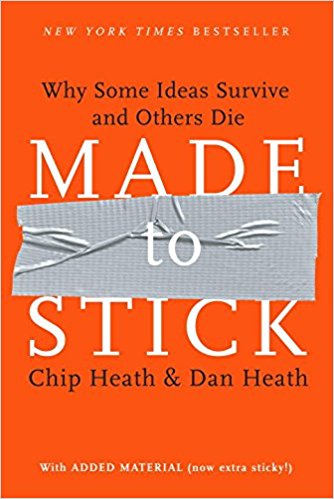Made To Stick Summary
PDF, Chapters & Review of Chip & Dan Heath’s Book
Made to Stick: Why Some Ideas Survive and Others Die
Authors: Chip Heath & Dan Heath
Click Here to Get the PDF Summary of This Book & Many More

To make our communications more effective, we need to shift our thinking from “What information do I need to convey?” to “What questions do I want my audience to ask?
Six principles of stickiness:
Simplicity
The essential core of an idea. E.g. The Golden Rule — a one-sentence statement of profundity
Unexpectedness
Violate people’s expectations to get them to pay attention to our ideas. Open gaps in their knowledge — and then fill them.
Set up puzzles — why is something the way it is? Create curiosity before showing the answer. Instead of asking, “What information do I need to convey?” ask “What questions do I want my audience to ask?”
Concreteness
Anything that can be explained in terms of sensory information. Concrete images are ice-filled bathtubs, apples with razors, etc. People can remember concrete easily visualized nouns (“bicycle”) rather than abstract ones (“justice”).
Easy test: Write down as many things that are white in color as you can think of. Compare that to: Write down as many things that are white in color in your fridge that you can think of.
Credibility
Statistics are rarely meaningful in and of themselves. Statistics will, and should, almost always be used to illustrate a relationship. It’s more important for people to remember the relationship than the number. Directional sense more important than specific numbers. Contextualize stats with real life analogies and examples — never leave the numbers on their own.
If I already intuitively “get” what you’re trying to tell me, why should I obsess about remembering it? The danger, of course, is that what sounds like common sense often isn’t…. It’s your job, as a communicator, to expose the parts of your message that are uncommon sense.
Emotional
Stories. Stories provide stimulation (knowledge about how to act) and inspiration (motivation to act).
Three types of story plots:
- The Challenge plot: underdog story, David & Goliath etc.
- The Connection plot: a relationship that bridges a gap (racial, class, religious, etc). A scrawny young man encounters a towering famous black athlete — a bottle of Coke links them.
- The Creativity plot.
Feature creep is an innocent process. An engineer looking at a prototype of a remote control might think to herself, “Hey, there’s some extra real estate here on the face of the control. And there’s some extra capacity on the chip. Rather than let it go to waste, what if we give people the ability to toggle between the Julian and Gregorian calendars?
Generative analogies
introduce new perceptions, explanations, and inventions. E.g. the metaphor of employees as cast members in a theatrical production can be communicated consistently: cast members don’t interview for a job, they audition for a role. When they are walking around the park, they are onstage.
E.g. the metaphor of employees as cast members in a theatrical production can be communicated consistently: cast members don’t interview for a job, they audition for a role. When they are walking around the park, they are onstage.
The most basic way to get someone’s attention is this: Break a pattern.
Click Here to Get a Free PDF with 40+ Business & Marketing Book Summaries
This work is licensed under a Creative Commons Attribution-Share Alike 3.0 Unported License.

